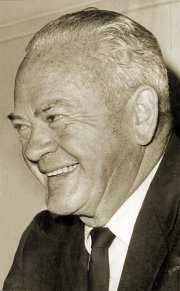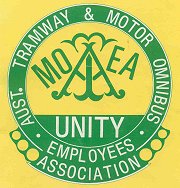Melbourne Tram Museum
- Follow Melbourne Tram Museum on Twitter
- Follow Melbourne Tram Museum on Facebook
- Follow Melbourne Tram Museum on Instagram
- Follow Melbourne Tram Museum on Pinterest
- Follow Melbourne Tram Museum on Tumblr
- Subscribe to Melbourne Tram Museum's RSS feed
- Email Melbourne Tram Museum
Clarrie O’Shea – hero or villain?
Clarrie O’Shea is a controversial figure in Australian industrial history. Reviled by conservatives as a communist stooge and union militant, he is upheld to this day by the radical left as a hero and defender of workers’ rights and privileges. A case can be made that he was a critical factor in the retention of Melbourne’s tramway system during the 1950s and 1960s, although this came at a heavy financial cost.
He was born Clarence Lyell O’Shea in 1906 in Tasmania. He became an employee of the Melbourne & Metropolitan Tramways Board (M&MTB) in the 1920s at North Melbourne, and was active early in his career in the Australian Tramway & Motor Omnibus Employees’ Association (ATMOEA). He assumed the role of ATMOEA State Secretary in the mid-1940s, a position he held for over thirty years.
O’Shea was a life-long Communist and vice-president of the pro-Chinese Communist Party of Australia (Marxist-Leninist) formed after the 1963 split of the Communist Party of Australia. In April-May of 1964 he led a delegation representing Maoist-aligned trade unions to Beijing, presenting a scroll emphasising the solidarity between Australian and Chinese workers. He was a long time official in the Australia-China Friendship Society.
Under O’Shea’s direction, the Victorian Branch of the ATMOEA was a militant campaigner for workers’ rights and privileges, particularly in the areas of shorter working hours, improved leave and sick pay allowances, and better retirement provisions. He had frequent clashes with the M&MTB management, especially after the formidable Major-General Sir Robert Risson was appointed Chairman in 1949. Risson’s predecessor, H.H. Bell, said of the union under O’Shea’s leadership that it was “like having a gun always pointed at your head”. Bell refused to believe that O’Shea represented the views of more than one in five tramway workers, and referred to him in private as nothing but a communist thug and bully.
O’Shea’s battles with Risson began almost immediately. In February 1950, the union under his direction went out on strike for an over-award payment of £2 per week, representing an increase of 15%. Risson lodged a court case which resulted in the deregistration of the ATMOEA, resulting in the union no longer being allowed to represent workers in the Arbitration courts. The strike continued for sixty days, and was ended only after the M&MTB agreed not to oppose re-registration of the ATMOEA. However, the union failed in its bid to get the over-award payment.
This battle set the pattern for relations between O’Shea and Risson for the next twenty years. The worst clashes were over the issue of one-man crews for buses. The M&MTB was under major pressure to cut costs due to falling passenger numbers, so wished to introduce one-man crews on its buses. The ATMOEA trenchantly opposed this initiative, seeing it as an attack on its workers’ job security, and the dispute ended up in the High Court. The result was a loss for M&MTB management, as the decision ruled that only new bus routes could be operated by one-man crews, and only on buses with no more than 31 seats.
Risson would spend the rest of his time as Chairman chipping away at this restriction on his ability to run the M&MTB on a more cost-effective basis, so there were frequent industrial disputes over this issue for the next twenty years.
Other battles were fought over the introduction of the 40 hour week – the standard award had M&MTB workers rostered for 44 hours – and inclusion of conductors’ pay-in time as part of their hours of employment.
There were also frequent clashes with the national leadership of the ATMOEA, which was under the control of moderates, lead by O’Shea’s former M&MTB colleague Reg Broadby.
Relations were so poisonous between M&MTB management and the Victorian branch of the ATMOEA that when in March 1968 a traffic inspector was transferred away from Malvern Depot, employees refused to operate services until it was discovered that the inspector concerned had been transferred at his own request. Over a period of five years from 1964 to 1969 the ATMOEA had accumulated 40 fines totalling $13,200 as a result of industrial action, none of which were paid by the union. O’Shea was ordered by the Commonwealth Industrial Court to provide the financial records of the ATMOEA, so that the court could determine the union’s ability to pay the outstanding fines. However, he point blank refused to provide the records.
The culmination of this conflict occurred on 15 May 1969 when O’Shea was jailed by Justice Kerr (later Sir John Kerr and Governor-General of Australia, notable for the sacking of the Whitlam Government) of the Commonwealth Industrial Court for contempt over the failure to answer summonses and pay fines totalling $8,100.
This sentencing resulted in national general strike action across a wide range of industries. There were a number of marches in many state capitals, often culminating in violent clashes between strikers and police. The level of public unrest caused anxiety to both Federal and State Governments, but they could not afford to be seen to back down, as they would otherwise appear to be soft on union militancy. This dilemma was only broken by the action of Dudley MacDougall, a former advertising manager for the Australian Financial Review, who paid the outstanding fines acting on behalf of an anonymous public benefactor who was said to have won the NSW State Lottery. O’Shea was released from Pentridge Prison on 21 May 1969.
On his release, O’Shea announced, “My release is a great victory for workers. I am certain that all workers remain adamant in their opposition to the penal powers, which are designed to suppress the workers. The infinite power of the workers when they are really aroused has frightened the life out of the government and the employers ... I am certain the workers will continue the struggle for the abolition of all penal powers.”
The jailing of O’Shea was the last use of the penal sections of the Conciliation and Arbitration Act, although these provisions have never been repealed, so O’Shea did not get his wish. In order to prevent similar mass action over industrial issues, the Fraser Government introduced in 1977 sections 45D and 45E of the Trade Practices Act, which outlaws secondary boycotts within Australia – the very mechanism used to place pressure on the government of the day in the O’Shea case. These secondary boycott provisions still remain in force, but the public outrage generated by the jailing of O’Shea has prevented similar court action by the Federal Government.
The retirement of Risson and his replacement by the more conciliatory Kirby in 1970 took much of the sting out of relations between the ATMOEA and the M&MTB, although throughout the 1970s there remained a significant level of tramway strikes – at least while O’Shea remained as State Secretary.
O’Shea’s leadership of the State branch of the ATMOEA did tremendous financial damage to the M&MTB, through the constant levels of industrial disputation and resultant losses of income, but more importantly over the one-man crew issue. As about 65% of M&MTB operating costs were staff-related, the inability of the M&MTB to use one-man crews on its trams and buses [1] was a major contribution to its haemorrhaging money from the early 1950s onwards. Early introduction of one-man crews would have cut M&MTB operating expenses by up to 30%. This initiative could have significantly delayed the introduction of substantial State Government annual operating subsidies, which rapidly rose from an initial $2,150,000 in 1970-71 to $49,850,000 in 1981-82, placing annual State Budgets under increasing pressure. As it was, one-man tram crews were not introduced until the 1990s.
Was this level of industrial militancy driven by O’Shea justified? Probably not, as the 1950s and 1960s were a time of full employment due to the post-war economic boom. The M&MTB had problems recruiting and retaining staff [2], even having to sponsor immigration from the United Kingdom to fill vacancies and make use of university students as conductors during term breaks. Had the M&MTB been able to introduce one-man crews on a widespread basis during this period, wholesale redundancies would have been unlikely.
A more conciliatory approach than O’Shea’s may have produced better results, particularly to the pay-packets of ATMOEA members through a reduced level of strikes. However, the question whether a different approach may have worked against the inflexible and intimidating Risson has to remain open. The inability of the M&MTB to utilise one-man crews removed much of the financial incentive to replace trams with lower capacity buses. Therefore, indirectly O’Shea and his militant industrial advocacy was a key element in the retention of Melbourne’s trams during his tenure as State Secretary of the ATMOEA.
Clarrie O’Shea died in 1988, a hero of the Australian trade union movement and the radical left.
Bibliography
Curlewis, D (1991) ‘Melbourne Tramways Dispute and Lockout’, Rebel Worker Vol 10 No 2 (79) March 1991
Jones, R. (2008) Fares Please: An economic history of the Melbourne & Metropolitan Tramways Board, Melbourne Tram Museum
Murray, R. (1993), ‘Broadby, Reginald Roslyn (Reg) (1904 - 1956)’, Australian Dictionary of Biography, Volume 13, Melbourne University Press
Pearsall, R. (1992) History of the ATMOEA, Rail, Tram & Bus Union NSW
Scott, K. (1999) Gareth Evans, Allen & Unwin
Vassilopoulos, J. (1997) ‘Lessons of the “Free Clarrie O’Shea” campaign’, Green Left Weekly
Footnotes
[1] The costs of imposed by two-man crews no doubt had some influence on the refusal of the Bolte State government to commit capital expenditure to the development of the M&MTB tramway system during the period 1956 to 1972. The only major influx of capital to the M&MTB during this period was between 1964 and 1966, and was associated with the acquisition of the Doncaster bus routes from a private bus company, development of Doncaster Bus Depot and purchase of one hundred AEC Regal Mark VI buses to operate these routes – all operated by one man crews. This initiative was approved due to the financial collapse of the private bus company, and the need for the Bolte government to win Lower House seats in the Doncaster mortgage belt area to retain its hold on government.
[2] Wages paid to M&MTB drivers and conductors during the 1950s and 1960s were competitive with average Australian wages, and employment with the tramways was seen as a secure long-term career choice. However, in common with many public transport jobs, significant use was made of split shifts, which together with the requirement for weekend work was a disincentive for many workers to stay with the tramways. Therefore, staff retention and associated costs was a major issue for the M&MTB.

